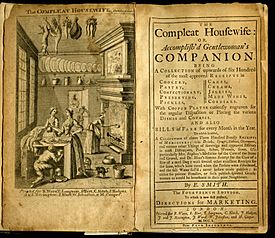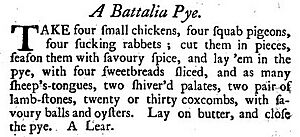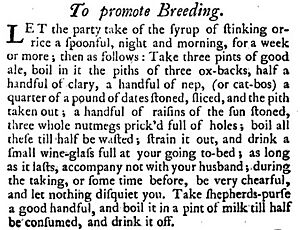The Compleat Housewife facts for kids

Frontispiece and title page of 14th edition, 1750
|
|
| Author | Eliza Smith |
|---|---|
| Country | England |
| Subject | English cooking |
| Genre | Cookery |
| Publisher | J. Pemberton |
|
Publication date
|
1727 |
The Compleat Housewife, or, Accomplish'd Gentlewoman's Companion is a famous cookery book written by Eliza Smith. It was first published in London in 1727. This book became super popular, with 18 different versions printed over 50 years!
It was also the very first cookery book to be published in America. This happened in Williamsburg, Virginia, in 1742. The book even had the first published recipe for "katchup" and seems to be where the idea for bread and butter pudding first appeared.
The book wasn't just about food. It also included recipes for making wines, special drinks called cordial-waters, and even medicines and healing salves.
Contents
About the Book
The full title of The Compleat Housewife tells you a lot about what's inside. It was a huge collection of hundreds of trusted recipes. These recipes covered everything from cooking and baking to making sweets, preserves, and even special drinks.
The book also had meal plans for every month of the year. Plus, it included almost 200 family recipes for medicines. These were for things like drinks, syrups, and ointments. They were meant to help with many sicknesses, pains, and wounds. These medicine recipes had never been shared publicly before.
This book was the first to print a recipe for "Katchup". This old ketchup recipe included ingredients like mushrooms, anchovies, and horseradish.
Not much is known about Eliza Smith herself. She wrote in the book's introduction that she worked as a cook or housekeeper for rich families for over 30 years. Unlike some other cookbook authors, she kept working in that job even after her book became a big hit. She didn't like how some male cookbook writers kept their best cooking secrets hidden. She wanted her readers to be able to use her recipes successfully.
What's Inside
Here's a look at what you could find in the 9th edition of the book from 1739:
- Preface (an introduction)
- A Bill of Fare for every Season of the Year (meal plans)
- Cookery, &c. (recipes for soups, meats, pies, fish, hams, sausages, cheese)
- All Sorts of Pickles
- All Sorts of Puddings
- All Sorts of Pastry
- All Sorts of Cakes
- Creams and Jellies
- Preserves, Conserves, and Syrups
- All Sorts of Made Wines
- All Sorts of Cordial-waters (sweet drinks)
- Medicines and Salves (home remedies)
How the Recipes Are Written
Eliza Smith's book didn't give general cooking tips. Each section was just a list of recipes. The recipes didn't have ingredient lists at the top. Instead, ingredients were mentioned as you read through the steps.
Most recipes also didn't tell you the oven temperature or how long to cook something. For example, a recipe for "To candy Orange Flowers" just says "set your glasses in a stove with a moderate heat." A recipe for "To Stew a Rump of Beef" says "this requires six or seven hours stewing."
The recipes were mostly English, but some dishes had French or other foreign names. They also used imported ingredients like spices.

The recipes were written very briefly. They didn't explain basic things like how to make pastry. For example, the recipe for "A Battalia Pye" doesn't even mention pastry, even though it tells you to "close the pye."
However, a few common parts of dishes were explained. These included "A Lear for Savoury Pyes" and "A Ragoo for made Dishes." A "Lear" was a thick sauce made with claret wine, gravy, oyster juice, anchovies, herbs, onion, and butter. A "Ragoo" had similar ingredients, plus sliced meats and mushrooms. These sauces were used in other recipes, like the Battalia Pye.
The book also included recipes for home-made medicines and remedies. One recipe was for a syrup to help women who wanted to have children. It called for a spoonful of "stinking orrice" syrup and a special ale boiled with ox-backs, herbs, dates, raisins, and nutmegs. These show how people used to make their own medicines at home.
Publishing History
In Britain
The book was first published in 1727. It went through 18 different editions (new printings) by 1773. The first four editions were published under the name "E— S—". But Smith did say she was a woman who had worked in "fashionable and noble Families" for over 30 years. The fifth edition in 1732 finally showed the author's name as "E. Smith".
A book expert named William Carew Hazlitt noted that the 7th edition included "nearly fifty Receipts being communicated just before the author's death." This means Eliza Smith added more recipes right before she passed away.
In America
The Compleat Housewife was the very first cookery book to be printed in America. This happened in Williamsburg, Virginia, in 1742. A printer named William Parks printed it. He was a smart and active printer from England.
His American version of the book was based on the fifth London edition from 1732. But he changed it to fit American tastes. He removed recipes that used ingredients that couldn't be found in America. Copies of this 1742 American edition are very rare today. Luckily, one copy is now back in Williamsburg, where it was first printed. It is kept in the Library of Colonial Williamsburg.
Editions
- 1st edition, London: J. Pemberton, 1727.
- 2nd edition, London: J. Pemberton, 1728.
- 3rd edition, London: J. Pemberton, 1729.
- 4th edition, London: J. Pemberton, 1730.
- 5th edition, London: J. Pemberton, 1732.
- --- Reprinted in Williamsburg, VA: W. Parks, 1742.
- 6th edition, London: J. Pemberton, 1734.
- 7th edition, London: J. and J. Pemberton, 1736.
- 8th edition, London: J. and J. Pemberton, 1737.
- 11th edition, London: J. and H. Pemberton, 1742.
- 12th edition, London: J. and J. Pemberton, 1744.
- 13th edition, London: H. Pemberton, 1746.
- --- reprinted 1747.
- 15th edition, London: R. Ware and others, 1753.
- --- London: Literary Services & Production, 1968, 1973.
- --- London: Studio Editions, 1994.
- --- With introduction by E. K. Wallace. Chawton House Library, 2009.
- 16th edition, London, 17__.
- 17th edition, London, 17__.
- 18th edition, London, 1773.


